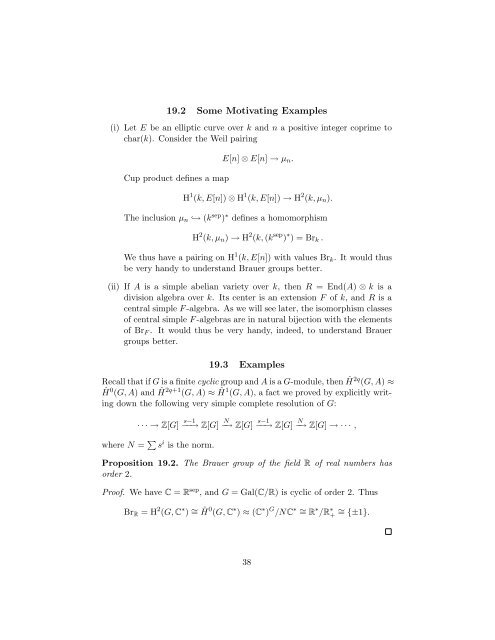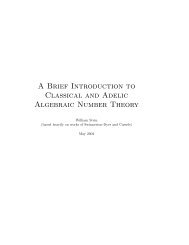A Short Course on Galois Cohomology - William Stein - University of ...
A Short Course on Galois Cohomology - William Stein - University of ...
A Short Course on Galois Cohomology - William Stein - University of ...
You also want an ePaper? Increase the reach of your titles
YUMPU automatically turns print PDFs into web optimized ePapers that Google loves.
19.2 Some Motivating Examples<br />
(i) Let E be an elliptic curve over k and n a positive integer coprime to<br />
char(k). C<strong>on</strong>sider the Weil pairing<br />
Cup product defines a map<br />
E[n] ⊗ E[n] → µn.<br />
H 1 (k, E[n]) ⊗ H 1 (k, E[n]) → H 2 (k, µn).<br />
The inclusi<strong>on</strong> µn ↩→ (k sep ) ∗ defines a homomorphism<br />
H 2 (k, µn) → H 2 (k, (k sep ) ∗ ) = Brk .<br />
We thus have a pairing <strong>on</strong> H 1 (k, E[n]) with values Brk. It would thus<br />
be very handy to understand Brauer groups better.<br />
(ii) If A is a simple abelian variety over k, then R = End(A) ⊗ k is a<br />
divisi<strong>on</strong> algebra over k. Its center is an extensi<strong>on</strong> F <strong>of</strong> k, and R is a<br />
central simple F -algebra. As we will see later, the isomorphism classes<br />
<strong>of</strong> central simple F -algebras are in natural bijecti<strong>on</strong> with the elements<br />
<strong>of</strong> BrF . It would thus be very handy, indeed, to understand Brauer<br />
groups better.<br />
19.3 Examples<br />
Recall that if G is a finite cyclic group and A is a G-module, then ˆ H 2q (G, A) ≈<br />
ˆH 0 (G, A) and ˆ H 2q+1 (G, A) ≈ ˆ H 1 (G, A), a fact we proved by explicitly writing<br />
down the following very simple complete resoluti<strong>on</strong> <strong>of</strong> G:<br />
· · · → Z[G] s−1<br />
−−→ Z[G] N −→ Z[G] s−1<br />
−−→ Z[G] N −→ Z[G] → · · · ,<br />
where N = s i is the norm.<br />
Propositi<strong>on</strong> 19.2. The Brauer group <strong>of</strong> the field R <strong>of</strong> real numbers has<br />
order 2.<br />
Pro<strong>of</strong>. We have C = R sep , and G = Gal(C/R) is cyclic <strong>of</strong> order 2. Thus<br />
BrR = H 2 (G, C ∗ ) ∼ = ˆ H 0 (G, C ∗ ) ≈ (C ∗ ) G /NC ∗ ∼ = R ∗ /R ∗ + ∼ = {±1}.<br />
38
















